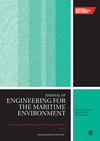傅里叶特征-物理信息神经网络(FF-PINN)在流体力学正反问题中的应用
IF 1.5
4区 工程技术
Q3 ENGINEERING, MARINE
Proceedings of the Institution of Mechanical Engineers, Part M: Journal of Engineering for the Maritime Environment
Pub Date : 2023-04-13
DOI:10.1177/14750902231166424
引用次数: 2
摘要
摘要物理信息神经网络(PINN)作为一种深度学习工具,近年来已成为求解边界/初始条件不明确且域内仅存在噪声稀疏测量值的反偏微分方程(PDEs)的有效方法。在具有多个频率尺度的领域中,PINN和其他神经网络倾向于收敛于低频解,这被称为频谱偏倚。对于PINN,这种情况发生在求解具有多频率尺度的空间和时间周期性行为的偏微分方程时。以往的研究表明,傅里叶特征神经网络(FF-NN)可以用来克服频谱偏倚问题。他们提出了多尺度-时空-傅立叶特征-物理信息神经网络(MS-ST-FF-PINN),以克服PINN解决的偏频问题。这已经在泊松方程、波方程和格雷-斯科特方程等基本偏微分方程上进行了评价。在本文中,我们将MS-ST-FF-PINN进一步应用于不可压缩的Navier-Stokes方程。此外,还比较分析了MS-ST-FF-PINN和MS-ST-FF-PINN结构的解精度、学习到的频率分量和收敛到正确解的速度。为了证明这一点,三个测试用例如图所示(a)-向前时间无关的双盖驱动腔,(b)-反时间无关的开尔文波型自由面估计,以及(c)-多圆柱体下游逆二维时间相关湍流冯·卡门涡脱落相互作用。结果表明,MS-ST-FF-PINN在早期训练迭代中同步学习低频和高频分量的能力优于即使经过多次迭代(如开尔文波型和卡门涡脱落案例)也不学习高频分量的PINN架构。然而,对于第三个测试用例,由于过度拟合,MS-ST-FF-PINN架构对压力场的时间预测显示出不连续性。本文章由计算机程序翻译,如有差异,请以英文原文为准。
On the use of Fourier Features-Physics Informed Neural Networks (FF-PINN) for forward and inverse fluid mechanics problems
Physics Informed Neural Networks (PINN), a deep learning tool, has recently become an effective method for solving inverse Partial Differential Equations (PDEs) where the boundary/initial conditions are not well defined and only noisy sparse measurements sampled in the domain exist. PINN, and other Neural Networks, tends to converge to the low frequency solution in a field that has multiple frequency scales, this is known as spectral bias. For PINN this happens when solving PDEs that exhibit periodic behavior spatially and temporally with multi frequency scales. Previous studies suggested that Fourier Features-Neural Networks (FF-NN) can be used to overcome the spectral bias problem. They proposed the Multi Scale-Spatio Temporal-Fourier Features-Physics Informed Neural Networks (MS-ST-FF-PINN) to overcome the spectral bias problem in PDEs solved by PINN. This has been evaluated on basic PDEs such as Poisson, wave and Gray-Scott equations. In this paper we take MS-ST-FF-PINN a step further by applying it to the incompressible Navier-Stokes equations. Furthermore, a comparative analysis between the PINN and the MS-ST-FF-PINN architectures solution accuracy, the learnt frequency components and the rate of convergence to the correct solution is included. To show this three test cases are shown (a)-Forward time independent double-lid-driven cavity, (b)-Inverse time independent free surface estimation of Kelvin wave pattern, and (c)-Inverse 2D time-dependent turbulent Von Karman vortex shedding interaction downstream of multiple cylinders. The results show that MS-ST-FF-PINN is better at learning low and high frequency components synchronously at early training iterations compared to the PINN architecture that does not learn the high frequency components even after multiple iteration numbers such as the Kelvin wave pattern and the Karman vortex shedding cases. However, for the third test case, the MS-ST-FF-PINN architecture showed a discontinuity for the temporal prediction of the pressure field due to over-fitting.
求助全文
通过发布文献求助,成功后即可免费获取论文全文。
去求助
来源期刊

CiteScore
3.90
自引率
11.10%
发文量
77
审稿时长
>12 weeks
期刊介绍:
The Journal of Engineering for the Maritime Environment is concerned with the design, production and operation of engineering artefacts for the maritime environment. The journal straddles the traditional boundaries of naval architecture, marine engineering, offshore/ocean engineering, coastal engineering and port engineering.
 求助内容:
求助内容: 应助结果提醒方式:
应助结果提醒方式:


